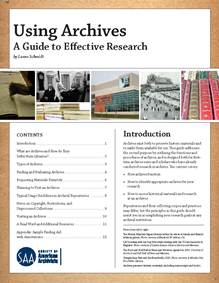
 Using Archives: A Guide to Effective Research
by
Using Archives: A Guide to Effective Research
by
Archives are where most people go to research using Primary Sources. What are Primary Sources? These are immediate, first-hand accounts of a topic from people who has a direct connection with the event. These often include correspondence, diaries, photographs, video, audio, speeches, legal documents, commercial transactions like receipts and ledgers, and administrative records for businesses or organizations. Newspapers can be primary and secondary sources depending on how the event is being reported.
Secondary Sources are also important, and you may want to start with them. These are materials one or two steps removed from the primary resource. They cover the topic or event but often take an analytical or interpretive position. This is why a newspaper can be both: it can report the event, or it can be a commentary on it. The most common secondary source is a book or article on the chosen topic. They are a good place to start because they have examined numerous primary sources to build their conclusions and they should cite them for you to reference.
You can begin by developing your research question. What is the topic, event, person, or era that you want to find out more. You might have an actual question; for example, what was life like for college students in Maryland before the 1950s?
Once you have your question you can begin to define your research needs and conduct preliminary research. You have hopefully narrowed your parameters, so you are not trying to cover too much. If you do have a broad topic, separate it into several research questions. You can begin your general research by looking at secondary sources. This will begin to show you what primary resources are available and where you can find them. You may need to adjust your expectations of what is really out there. Sometimes things are lost to time or they have not been made available to researchers yet. Understand that not everything is online, digitization is a slow, laborious and expensive for archives, and so you might need to make some research trips. You may have to do some digging or get creative with your question. You should also give yourself plenty of time.
With that being said, archives are always trying to make their materials more accessible to researchers. There are many ways they go about this. You can use a site like ArchivGrid to search the online catalogs of numerous institutions at once. One way to find what you need is to identify what types of primary resources you are looking for. Government documents will always be with the municipal archives at either the city, county, state, or federal level. Historical Societies both state and county are great sources for papers of businesses and families from the areas. Some corporations keep their own archives, but they might be private and not open to the public. This may also be the case with religious or organizational archives. There are also College and University archives like Washington College’s. They will have collection focuses but are a good source for alumni or faculty collections.
Once you have identified a collection you want to use you will need to know what you really need from it. Collections can range from a single item to hundreds of boxes. They can also be described down to each item or only tell you what is in a box generally. This is where you use the finding aid, a written description and inventory of the collection. It will contain subject terms, biographical notes, and scope and content notes. Reading these will always let you know if you are looking in the right place. There will usually be an inventory of what is in the collection and where you can find it. Knowing this will help you, and the archivist, get you what you need quickly.
Every archive has its own forms and policies regarding access to their materials. For example, you might need to show an ID, pens may not be allowed, and you might need to ask before photographing any items with your phone. These rules are in place to ensure the longevity of the materials so please respect them and the staff there to enforce them. Even here at Washington College you will need to read and sign an agreement on conduct in our archive.
Never be afraid to ask the archivist if you hit a dead end, they know these collections and can help you out.
Just like with books and website, you need to cite any archival materials you quote or paraphrase.. Regardless of the citation style you use, here are the key elements you will need based on our collections. The finding aid can help you identify these required elements.
Title – The title of the file or item, provide a short description of the material if untitled
Ex. Letter from Jonathan W. Bintton, 1856
Ex. Provost Smith desk book, undated
Name of Collection or Records Group – This is the name given to collection or records group the materials are in
Ex. Joseph Burchinal papers
Ex. Washington College Presidents’ papers, early Presidents’ papers
Reference Code – this is also called the identifier. Just like call numbers, these are used to organize and find items within the archives. Collections that are created by the functioning of the college are prefaced with WAC, while collections not directly created by the college are given MS. You may also need to make note of the box and folder numbers
Ex. MS 0006
Ex. WAC 003-001
Coming Soon!